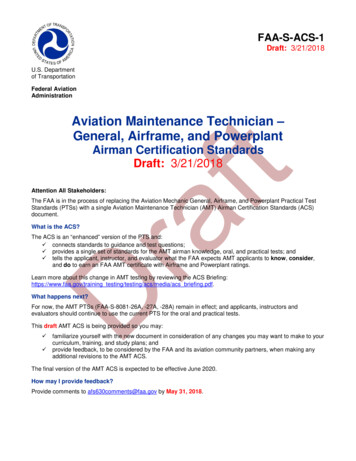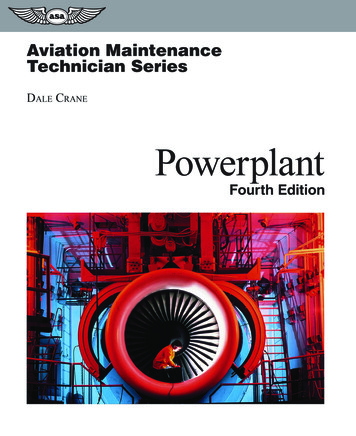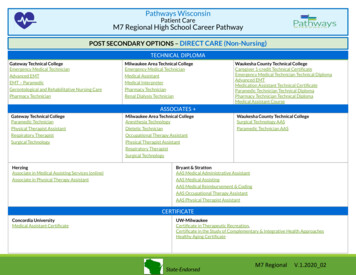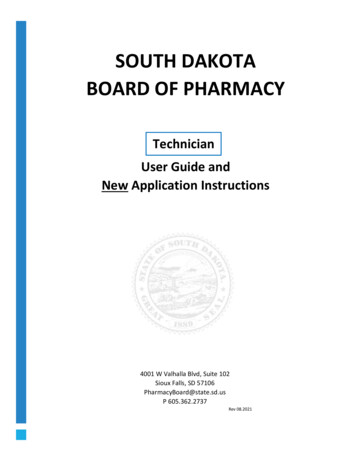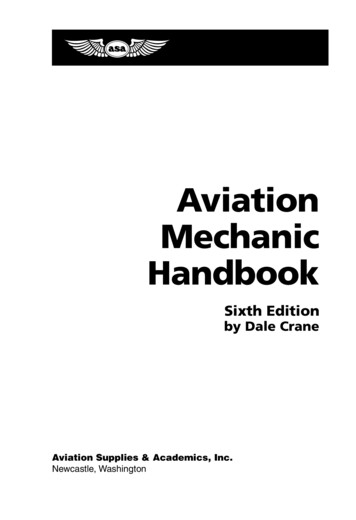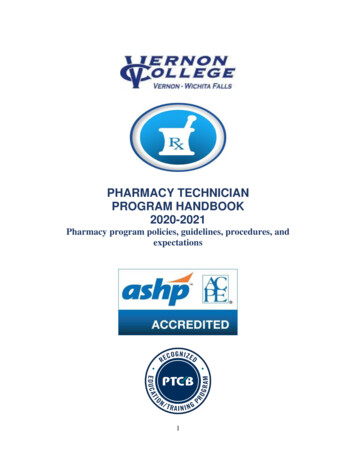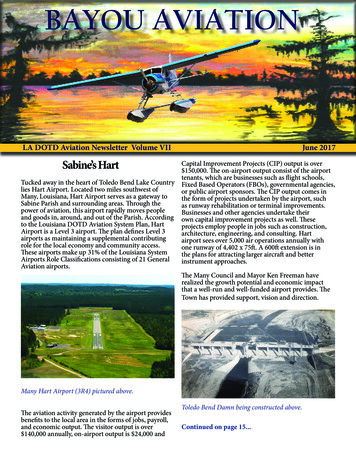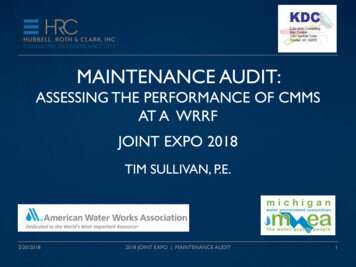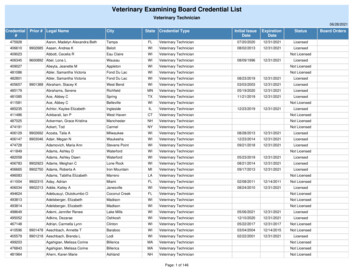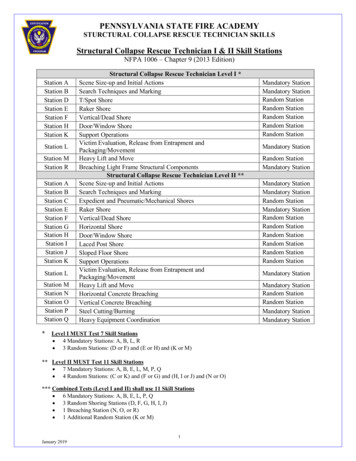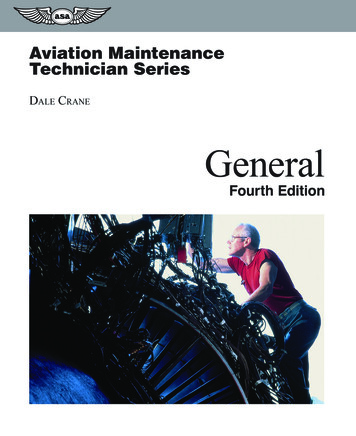
Transcription
Aviation MaintenanceTechnician SeriesGeneralFourth EditionDale CraneTerry MichmerhuizenTechnical EditorSchool of Aviation SciencesWestern Michigan UniversitySean FortierTechnical EditorCollege of Aviation and Aeronautical ScienceLeTourneau UniversityAviation Supplies & Academics, Inc.Newcastle, Wash ingtonAviation Supplies & Academics, Inc.i
Aviation Maintenance Technician Series: GeneralFourth Editionby Dale CraneEdited by Terry Michmerhuizen and Sean FortierAviation Supplies & Academics, Inc.7005 132nd Place SENewcastle, Washington 98059-3153Email: asa@asa2fly.comWebsite: www.asa2fly.com 1993 –2017 Aviation Supplies & Academics, Inc.All rights reserved. None of the material in this textbook supersedes any operationaldocuments, regulations or procedures issued by the Federal Aviation Administration,or aircraft and avionics manufacturers’ guidelines and instructions.First Edition published 1993. Fourth Edition published 2017.Cover photo Gary Gladstone / The Image BankPhotos pp. 3, 5 and 7 courtesy Museum of Flight FoundationPhotos pp. 4 and 6 courtesy The Boeing CompanyPhoto p. 450 courtesy Rosenfeld Images Ltd./Science Photo LibraryFigures 5-1 through 5-7 and 5-11 on pp. 350-353 and 356 courtesy Judah RutledgePhoto p. 570 courtesy All Foam Products Co.ASA-AMT-G4-PDISBN 978-1-61954-518-2iiAviation Maintenance Technician SeriesGeneral
ContentsPrefacev1An Introduction to Aviation2Mathematics3Basic Physics4Basic Electricity5Aircraft Drawings6Weight and Balance7Materials and Processes8Cleaning and Corrosion Control9Fluid Lines and Fittings1115913334737942148953710Ground Operation and Servicing11Regulations and Maintenance Publications12Mechanic Privileges and Limitations13Maintenance Forms and Records14Tools for Aircraft Maintenance15Entering the Field of Aviation Maintenance16Human ation Supplies & Academics, Inc.Contentsiii
PrefaceAviation maintenance technology has undergone tremendous changes inthe past decades. Modern aircraft, with their advanced engines, complexflight controls, and environmental control systems, are some of the mostsophisticated devices in use today, and these marvels of engineeringmust be maintained by knowledgeable technicians. The Federal AviationAdministration, recognizing this new generation of aircraft, has updated therequirements for maintenance technicians and for the schools that providetheir training. The FAA has instituted an Aviation Maintenance TechnicianAwards Program for technicians and their employers to encourage technicians to update their training.New technologies used in modern aircraft increase the importance ofmaintenance technicians having a solid foundation in such basic subjects asmathematics, physics, and electricity. The Aviation Maintenance TechnicianSeries has been produced by ASA to provide the needed background information for this foundation and to introduce the reader to aircraft structures,powerplants, and systems.These texts have been carefully designed to assist a person in preparingfor FAA technician certification, while at the same time serving as a valuablereference for individuals working in the field. The subject matter is organizedinto the categories used by the FAA for the core curriculum in 14 CFR Part147, “Aviation Maintenance Technician Schools” and for the Subject Matter Knowledge Codes used in the written tests for technician certification.These categories have been rearranged in the ASA series to provide a morelogical progression of learning. For example, in the General textbook thebasic subjects are covered first, then the technical subjects common to bothairframe and powerplant certification, and finally the maintenance publications, forms, and records that are so important.The author and publisher of the Aviation Maintenance Technician Serieswish to express our appreciation to the various manufacturers, aviationmaintenance technician schools, and FAA personnel who have assisted usin producing this coordinated training series. Special appreciation goes toTerry Michmerhuizen of Western Michigan University School of AviationSciences for his valuable assistance in editing these texts.Dale CraneAviation Supplies & Academics, Inc.v
About the Author and EditorsDale Crane (1923 – 2010) was involved in aviation for more than 50 years.He began his career in the U.S. Navy as a mechanic and flight engineer inPBYs. After World War II, he attended Parks Air College. After college, heworked as an instrument overhaul mechanic, instrument shop manager, andflight test instrumentation engineer. Later he became an instructor and thendirector of an aviation maintenance school.Dale was active as a writer of aviation technical materials, and as a consultant in developing aviation training programs. ATEC presented to DaleCrane their special recognition award for “his contribution to the development of aviation technicians as a prolific author of specialized maintenancepublications.” He also received the FAA’s Charles Taylor “Master Mechanic”award for his years of service in and contributions to the aviation maintenance industry, and the recognition of his peers for excellence as a leaderand educator in aircraft maintenance, and aviation safety advocate.Terry Michmerhuizen, technical editor for the previous editions, is anAssociate Professor at the College of Aviation, Western Michigan University. He obtained his A&P Certificate in 1974, and received his IA rating in1994. He has a Bachelor of Science in Mechanical Engineering Technologyand a Master’s Degree in Management. He was employed for 18 years at anaerospace hydraulic manufacturing and repair facility. He also worked 14years as a certification engineer at a large FAA-authorized repair station forcorporate aviation.Sean Fortier is technical editor for the Fourth Edition; he is the AssociateDean and Chair of the Applied Aviation Science Department in the Collegeof Aviation at LeTourneau University. He studied electrical engineering atColorado University before transferring to Moody Bible Institute’s Aviationprogram, earning his Airframe and Powerplant Certificate, Private Pilot Certificate, and FCC General Radiotelephone Operator License in the processof obtaining his Bachelor of Science in Missionary Aviation Science. Seanstarted his time at LeTourneau in 1994 in the aviation maintenance technologyprogram, focusing on teaching aircraft electrical systems and avionics. In1998 he earned his Master’s Degree in Systems Technology from LouisianaState University Shreveport.viAviation Maintenance Technician SeriesGeneral
2MathematicsWhy Study Mathematics?Numerals15Arabic NumeralsRoman NumeralsNumber SystemsDecimal SystemBinary 9Multiplication20Division22Study Questions: ArithmeticFractions152324Common Fractions24Addition of Common Fractions24Subtraction of Common Fractions25Finding the Smallest Common Denominator25Reducing a Fraction to its Lowest Term27Multiplication of Common Fractions28Division of Common Fractions28Mixed Numbers28Study Questions: Common Fractions and Mixed Numbers29Decimal Fractions30Addition of Numbers Containing Decimal Fractions30Subtraction of Numbers Containing Decimal Fractions31Multiplication of Numbers Containing Decimal Fractions31ContinuedMathematicsChapter 211
Division of Numbers Containing Decimal Fractions31Converting Common Fractions into Decimal Fractions32Converting Decimal Fractions into Common Fractions32Rounding Numbers32Study Questions: Decimal Fractions and Rounding Numbers33Ratio and Proportion34Ratio34Proportion35Study Questions: Ratio and ProportionPercentage3637One Number Which is a Given Percentage of Another37The Percentage One Number is of Another37A Number of Which a Given Percentage is Known38Study Questions: Percentage38Signed Numbers39Adding Signed Numbers39Subtracting Signed Numbers39Multiplying Signed Numbers39Dividing Signed Numbers40Study Questions: Signed NumbersPowers and Roots41Powers41Roots41Study Questions: Powers and RootsScientific Notation404242Changing Numbers into Scientific Notation42Changing Scientific Notation into Ordinary NumbersAdding Numbers Using Scientific Notation43Subtracting Numbers Using Scientific Notation43Multiplying Numbers Using Scientific Notation44Dividing Numbers Using Scientific Notation44Raising Numbers to Powers Using Scientific NotationStudy Questions: Scientific Notation44124344Aviation Maintenance Technician SeriesGeneral
Trigonometry46Angles and their MeasurementTriangles46Trig Functions47Tangent48Sine and Cosine48Vector Quantities49Cotangent, Secant, and CosecantStudy Questions: TrigonometryMathematical Sequence46505052Study Question: Mathematical SequencePractical Measurements5253Area53Force54Volume54Study Questions: Practical MeasurementsAnswers to Chapter 2 Study Questions5556MathematicsChapter 213
MathematicsWhy Study Mathematics?Mathematics is an exact science that gives us the basic language for alltechnology, and without it, aviation as we know it could not exist. We usemathematics daily for a variety of tasks, from figuring our paycheck todetermining the strength of a riveted joint.Today, a knowledge of mathematics is more important than ever before.All aircraft, engines, and the systems they contain must obey the laws ofphysics, and only by using the tools of mathematics are engineers able todesign equipment that follows these laws. And only by understanding andusing mathematics are we as technicians able to maintain this equipment soit will continue to function properly.The miracle of modern engineering and production is possible onlybecause of computers that quickly and accurately make the vast number ofmathematical computations that are needed. Pocket-size calculators help totake the boredom out of mathematics and free the technician to concentrateon the practical use of this science.In this section, we begin with a review of the number systems commonlyused and progress through the four basic procedures in arithmetic, througha discussion of common and decimal fractions, percentage, ratio and proportion, powers and roots, signed numbers, and trigonometry, and concludewith mathematical sequences and practical problems.To gain the most from this chapter, work all of the study problems byhand and check your answers with a pocket calculator; then check with theanswers in the back of this chapter. By practicing the old-fashioned way ofworking problems, you will sharpen your skills and better understand themathematical process.NumeralsNumerals are the symbols used in mathematics to represent values. We aremost familiar with the Arabic numerals, but Roman numerals have somespecial functions.Arabic NumeralsPractically all modern mathematics are performed with Arabic numerals.This series of ten symbols is thought to have been developed by the Hindusin India and introduced in Europe by the Arabs.MathematicsArabic numerals. The symbols 0, 1, 2, 3,4, 5, 6, 7, 8, and 9 used to represent valuesin the decimal number system.Chapter 215
The ten symbols may be arranged in such a way that they represent anyquantity we want, and we use Arabic numerals, also called digits, in boththe decimal and binary number systems.The ten Arabic numerals are: 0, 1, 2, 3, 4, 5, 6, 7, 8, and 9.Roman NumeralsRoman numerals were used in an ancient number system, and are occasionallyused as the chapter numbers in some books and on some of the more decorative clock faces. Seven capital letters represent numbers, and combinationsof these letters may be used to make up any value we want. Mathematicalmanipulation of these numerals is too awkward for us even to consider here.The seven Roman numerals and their Arabic equivalent are seen inFigure 2-1.Number SystemsFigure 2-1. Comparison of Roman andArabic numeralsDecimal SystemThe number system used every day in aviation maintenance is the decimalsystem. It is based on the ten Arabic numerals, and we can arrange theseten digits so they represent any value we want. We do this by observing theposition the digits occupy in the string of digits. The value of the digits in adecimal number is determined by their placement relative to the decimal point.The easiest way to understand the decimal system is to use a numberline, Figure 2-2. The center of the number line is marked with a small dotsimilar to a period used in writing. This is called the decimal point or, moregenerally, just “the decimal.”Figure 2-2. On the number line, all numbers to the left of the decimal point arewhole numbers, and all numbers to the right of the decimal point are fractional parts of awhole number.Figure 2-3. Place values for numbersgreater than 1 in the decimal systemThe digit in the first place to the left of the decimal point has a valuebetween 1 and 9. The digit in the second place has a value between 10 and90, and the digit in the third place has a value between 100 and 900. Thiscontinues on, with each place to the left increasing the value by ten times.To find the exact value of any number, just add all of the place values tothe left of the decimal point. For example, we can break the number 52,496down as shown in Figure 2-3.16Aviation Maintenance Technician SeriesGeneral
In the United Kingdom, the decimal is placed above the line (·), butin the United States the decimal is placed on the line (.), and the raised dot(·) is used to indicate multiplication. All numbers to the left of the decimalpoint are numbers greater than 1, and those to the right of the decimal arefractions, or numbers less than 1.The digit in the first place to the right of the decimal point has a valuebetween 1 10 and 9 10, and the digit in the second place has a value between1 100 and 9 100. The value of the digits becomes smaller by a factor of ten foreach place the digit is to the right of the decimal point (see Figure 2-4). Thenumber 347.69 can be broken down as we see in Figure 2-5.For whole numbers greater than 1, the decimal point is normally omitted,and for numbers less than 1, a zero is normally placed before the decimal point.Binary SystemAll data used by digital computers is represented with only two electricalconditions, OFF or ON. This can also be LOW or HIGH, or NEGATIVE orPOSITIVE. Computers can do many different things when they are commanded by combinations of these two conditions.To get the most value from digital computers, we must be able to reduceall of the data we use to a series of numbers, and since the computer recognizes only two conditions, we use the binary number system. This systemuses only two symbols, 0 and 1. These are called bits (BInary digiTS).In the binary system the value of the bits doubles as they progress fromright to left. The values of the first ten bits, reading from right to left, are: 1,2, 4, 8, 16, 32, 64, 128, 256, and 512, as shown in Figure 2-6.Figure 2-4. Place values for numberssmaller than 1 in the decimal systemFigure 2-5. Place values for mixednumbers in the decimal systemFigure 2-6. Conversion between the binary and decimal systemMathematicsChapter 217
To find the binary equivalent of a decimal number, start with the leftside of the chart and subtract the binary place values from the decimal number. Proceeding to the right, every time a place value goes into the decimalnumber, put a 1 for the place value. When a place value does not go intothe decimal number, put a zero for that place value. For example, the binaryequivalent of 152 is 10011000: 152 – 128 24, so 1 goes in the 128 column 64 is greater than 24, so 0 goes in the 64 column 32 is greater than 24, so 0 goes in the 32 column 24 – 16 8, so 1 goes in the 16 column 8 – 8 0, so 1 goes in the 8 column There is nothing left, so 0 goes in the 4, 2, and 1 columnsAny zeros to the left of the first 1 may be omitted without changing the valueof the binary number.To find the decimal equivalent of a binary number, add all of the placevalues in which there is a 1. The decimal equivalent of 0100111000 is 312. Start at the right and add the place values in which there is a 1 0 0 0 8 16 32 0 0 256 312ArithmeticArithmetic is essentially the branch of mathematics in which we use addition,subtraction, multiplication, and division to solve problems that may containpositive and negative numbers and zero.The pocket calculator has just about spoiled us for working arithmeticproblems the old-fashioned way, but it is a good idea to review a few principles. Practicing may prevent some common mistakes.Additionaddition. The process of finding thecombined value of two or more numbers.Addition is the process of finding the combined values of two or more numbers, their sum. The symbol for addition is the plus sign ( ).To find the sum, arrange the numbers in a vertical column with thedecimal points all in a line, and combine the values of the numbers in eachcolumn. Since most whole numbers are written without a decimal point, justalign the numbers with the least significant digits, the digits on the right, allin a straight vertical line. See Figure 2-7.Figure 2-7. Arrangement of numbers foraddition18Aviation Maintenance Technician SeriesGeneral
1. Arrange the numbers for addition, and combine the values of all of thedigits in the ones column, the column on the right. When all of thesedigits are added together, they total 21. Twenty-one is 2 tens plus 1 one.Place the 1 below the ones column, and carry the 2 above the tens column. See Figure 2-8.2. Combine the value of all of the digits in the tens column, including the2 you just carried. The sum of these four digits is 14. This is 1 hundred,plus 4 tens. Put the 4 below the tens column and carry the 1 at the topof the hundreds column.3. Now, combine the values of the digits in the hundreds column. This is 7plus 1, or 8. Place the 8 below the hundreds column, and this gives thesum of the four numbers, which is 841.Figure 2-8. The process of additionsum. The answer in an addition problem.least significant digit. The digit on theextreme right in a decimal number.The best way to check the accuracy of an addition problem is to add thenumbers in a different sequence. If you added them the first time from thetop number down, check by adding them from the bottom to the top.Before leaving addition problems, there is one fact that will help inpractical problems: It makes no difference in which order we add numbers.6 4 4419 519 5 6 5 6 1934 34 34SubtractionSubtraction is the process of finding the difference between two numbers.The symbol for subtraction is the minus sign (–).The number you begin with is called the minuend, and the number yousubtract, or take away, from this is called the subtrahend. The answer iscalled the difference.In Figure 2-9 we find the difference between 486 and 32. Place the subtrahend, 32, under the minuend, 486, with the least significant digits, theright-hand digits, lined up. Find the difference between the values of the digitsin the ones column. 6 – 2 4. Place the 4 below the 2 in the ones column.Find the difference between the values of the digits in the tens column.This is 8 – 3 5. Place the 5 below the tens column.Since there is no number in the hundreds column of the minuend, justplace the 4 in the answer in the hundreds column.The difference between 486 and 32 is 454.Some subtraction problems have digits in the subtrahend that are largerthan those in the minuend, and we have to do some borrowing.Mathematicssubtrahend. The number in a subtractionproblem that is to be subtracted.minuend. The quantity in a subtractionproblem from which another quantity is tobe subtracted.difference. The amount by which onequantity is greater or less than another.Thedifference is the answer in a subtractionproblem.Figure 2-9. This subtraction process doesnot involve borrowing.Chapter 219
In Figure 2-10, we see this situation:A. We want to find the difference between 234 and 76.B. Six ones is larger than 4 ones, so we must borrow 10 ones from the 3 inthe tens column. This gives us 14 ones, and 6 from 14 leaves 8. Placethe 8 in the ones column of the answer.C. Seven is larger than 2, so we must borrow 10 tens from the hundredscolumn to get 12 tens. Seven from 12 gives us 5 tens in the answer.D. We had to borrow 10 tens, or 1 hundred from the 2 hundreds, so we have1 left in the hundreds column. Place a 1 in the hundreds column of theanswer.Figure 2-10. This subtraction process doesinvolve borrowing.To check a subtraction problem, add the subtrahend to the difference, andif the problem has been worked correctly, the sum will be the same as theminuend.MultiplicationMultiplication is a process in which one number is added to itself a givennumber of times.Various symbols are used to indicate the multiplication process. Theseare the letter “x,” or a small dot placed in the center of the space “·,” orparentheses. Parenthesis are used in problems in which other functions mustbe applied to terms before they are multiplied.5 x 8 x 10 4005 · 8 · 10 400(3 2) (12 – 4) (6 4) 400Figure 2-11. The process of multiplicationmultiplicand. The number in amultiplication problem that is multiplied.multiplier. The number in a multiplicationproblem by which the other number, themultiplicand, is multiplied.product. The answer in a multiplicationproblem.The number to be multiplied is called the multiplicand, and the numberused to multiply is called the multiplier. The answer is called the product.The multiplication problem 4 · 3 12 is the same as four added to itselfthree times: 4 4 4 12.When multiplying numbers having more than one digit, the way wearrange them is important. This is shown in Figure 2-11.A. To multiply 365 by 124, begin by multiplying 365 by 4.1. First, multiply 5 by 4. 5 · 4 20Place the 0 in the ones column of the answer and carry the 2 abovethe tens column.2. Now, multiply 6 tens by 4 and add the 2 tens we carried.4 · 6 24 2 26 (This is actually (4 · 60) 20 260.)Place the 6 in the tens column of the answer, and carry the 2 (200)above the hundreds column.3. Multiply 3 hundreds by 4, and add the 2 hundreds we carried.20Aviation Maintenance Technician SeriesGeneral
4 · 3 12 2 14 (This is actually (4 · 300) 200 1400.)Place the 4 in the hundreds column of the answer and the 1 in thethousands column. The answer for our first step is 1,460.B. The second stage is to multiply 365 by 2 in the tens column (20).1. Multiply 5 by the 2 in the tens column. 5 · 2 10(This is actually 5 · 20 100.)Place the zero in the tens column and carry the 1 (10) above the tenscolumn.2. Multiply 6 tens by 2 tens, and add the 10 tens we carried.6 · 2 12 1 13 (This is actually (60 · 20) 100 1300.)Place the 3 in the hundreds column and carry the 1 (100) above thehundreds column.3. Multiply 3 hundreds by 2 tens, and add the 10 hundreds we carried.3 · 2 6 1 7 (This is actually (300 · 20) 1000 7000.)Place the 7 in the thousands column.C. The final stage is to multiply 365 by 1 in the hundreds column (100).1. Multiply 5 by 1 hundreds. 5 · 1 5 (This is actually 5 · 100 500.)Place the 5 in the hundreds column.2. Multiply 6 tens by 1 hundreds. 6 · 1 6(This is actually 60 · 100 6000.)Place the 6 in the thousands column.3. Multiply 3 hundreds by 1 hundred. 3 · 1 3 (This is actually300 · 100 30,000)Place the 3 in the ten thousands column.4. Add all the numbers we have just created to get the product of365 · 124 45,260.To check a multiplication problem, divide the product by the multiplier, andyou should get the multiplicand.45,260 124 365In a multiplication problem involving several steps of multiplication, theorder in which the numbers are multiplied has no effect in obtaining thecorrect answer.6 · 5 · 9 · 20 5,40020 · 5 · 6 · 9 5,4009 · 6 · 20 · 5 5,4005 · 20 · 9 · 6 5,400MathematicsChapter 221
Divisiondividend. The quantity in a divisionproblem that is divided.divisor. The quantity in a division problemby which the dividend is divided.quotient. The answer in a divisionproblem.remainder. The number left in a divisionproblem when the divisor does not go intothe dividend an even number of times.Division is the process of determining the number of times one numberwill go into another. The number to be divided is called the dividend, thenumber that is to go into the dividend is called the divisor, and the answeris the quotient. The symbols for division are , and /.Division can actually be thought of as a series of subtractions. We canfind the number of times 7 will go into 56 by subtracting 7 from 56 until weget zero. Seven will go into 56 eight times. See Figure 2-12.If the divisor does not go into the dividend an even number of times, thenumber left over is called the remainder.42 5 8, remainder 2Long division is the term we generally use when the divisor has two ormore digits. To solve a long division problem, we arrange it as we see inFigure 2-13.1. Place the dividend under the division sign, and the divisor to the left ofit.Figure 2-12. Division is actually a seriesof subtractions. 56 7 8Figure 2-13. The process of long divisionThe 24 of the divisor will go into 136 of the dividend 5 times, withsome remainder. Place the 5 above the 6. Multiply the 24 by 5, to get120. Place the 120 below the 136.Subtract 120 from 136 to get 16 as the remainder for our first step.2. Bring the 8 from the dividend down and place it after the remainder togive us a new dividend of 168.The 24 of the divisor will go into the new dividend 7 times. Place the7 above the 8 and multiply the 24 by 7. Place the product of 168 belowthe new dividend and subtract. Since there is no difference, there is noremainder in this problem.Twenty-four will go into 1,368 fifty-seven times.Division problems may be written in any of the ways we see in Figure 2-14.Figure 2-14. Ways of writing divisionproblems22Aviation Maintenance Technician SeriesGeneral
STUDY QUESTIONS: ARITHMETICWork all of these problems by hand, and then you may check your accuracy with a calculator. Answers are found at the end of the chapter.1. Find the sum of each of these columns of numbers:a. b. c. d.32166596656816385837473718499367279313652. Find the difference between each of these numbers:a. b. c. d.458196756475296480539183. Find the product in each of these multiplication problems:a. b. c. d.2486219691423062129841774. Find the quotient and remainder of each of these division problems:a.b.c.d.3685 92 remainder5694 23 remainder148 53 remainder98 7 remainderMathematicsChapter 223
AVIATION SUPPLIES & ACADEMICS, INC. i Aviation Maintenance Technician Series General Aviation Supplies & Academics, Inc. Newcastle, washiNgtoN Dale craNe terry MichMerhuizeN Technical Editor school of aviatioN scieNces westerN MichigaN uNiversity seaN fortier Technical Editor college of aviatioN aND
